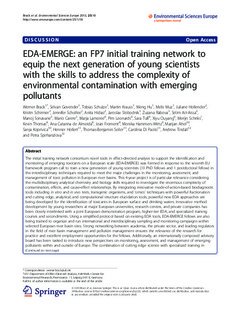EDA-EMERGE: an FP7 initial training network to equip the next generation of young scientists with the skills to address the complexity of environmental contamination with emerging pollutants
| dc.contributor.author | Brack, Werner | |
| dc.contributor.author | Govender, Selvan | |
| dc.contributor.author | Schulze, Tobias | |
| dc.contributor.author | Krauss, Martin | |
| dc.contributor.author | Hu, Meng | |
| dc.contributor.author | Muz, Melis | |
| dc.contributor.author | Hollender, Juliane | |
| dc.contributor.author | Schirmer, Kristin | |
| dc.contributor.author | Schollee, Jennifer | |
| dc.contributor.author | Hidasi, Anita | |
| dc.contributor.author | Slobodnik, Jaroslav | |
| dc.contributor.author | Rabova, Zuzana | |
| dc.contributor.author | Ait-Aissa, Selim | |
| dc.contributor.author | Sonavane, Manoj | |
| dc.contributor.author | Carere, Mario | |
| dc.contributor.author | Lamoree, Marja | |
| dc.contributor.author | Leonards, Pim | |
| dc.contributor.author | Tufi, Sara | |
| dc.contributor.author | Ouyang, Xiyu | |
| dc.contributor.author | Schriks, Merijn | |
| dc.contributor.author | Thomas, Kevin | |
| dc.contributor.author | Almeida, Ana Catarina | |
| dc.contributor.author | Froment, Jean | |
| dc.contributor.author | Hammers-Wirtz, Monika | |
| dc.contributor.author | Ahel, Marijan | |
| dc.contributor.author | Koprivica, Sanja | |
| dc.contributor.author | Hollert, Henner | |
| dc.contributor.author | Seiler, Thomas-Benjamin | |
| dc.contributor.author | Di Paolo, Carolina | |
| dc.contributor.author | Tindall, Andrew | |
| dc.contributor.author | Spirhanzlova, Petra | |
| dc.date.accessioned | 2018-06-20T09:26:11Z | |
| dc.date.available | 2018-06-20T09:26:11Z | |
| dc.date.issued | 2013 | |
| dc.identifier.citation | Environmental Sciences Europe. 2013, 25 (18), 7. | nb_NO |
| dc.identifier.issn | 2190-4715 | |
| dc.identifier.uri | http://hdl.handle.net/11250/2502242 | |
| dc.description.abstract | The initial training network consortium novel tools in effect-directed analysis to support the identification and monitoring of emerging toxicants on a European scale (EDA-EMERGE) was formed in response to the seventh EU framework program call to train a new generation of young scientists (13 PhD fellows and 1 postdoctoral fellow) in the interdisciplinary techniques required to meet the major challenges in the monitoring, assessment, and management of toxic pollution in European river basins. This 4-year project is of particular relevance considering the multidisciplinary analytical chemistry and biology skills required to investigate the enormous complexity of contamination, effects, and cause-effect relationships. By integrating innovative mode-of-action-based biodiagnostic tools including in vitro and in vivo tests, transgenic organisms, and ‘omics’ techniques with powerful fractionation and cutting edge, analytical, and computational structure elucidation tools, powerful new EDA approaches are being developed for the identification of toxicants in European surface and drinking waters. Innovative method development by young researchers at major European universities, research centers, and private companies has been closely interlinked with a joint European demonstration program, higher-tier EDA, and specialized training courses and secondments. Using a simplified protocol based on existing EDA tools, EDA-EMERGE fellows are also being trained to organize and run international and interdisciplinary sampling and monitoring campaigns within selected European river basin sites. Strong networking between academia, the private sector, and leading regulators in the field of river basin management and pollution management ensures the relevance of the research for practice and excellent employment opportunities for the fellows. Additionally, an internationally composed advisory board has been tasked to introduce new perspectives on monitoring, assessment, and management of emerging pollutants within and outside of Europe. The combination of cutting edge science with specialized training in complimentary soft skills is being offered with a strong emphasis on commercial exploitation and media competence which further enhances the employability of the fellows in research, academia, and beyond. | nb_NO |
| dc.language.iso | eng | nb_NO |
| dc.publisher | SpringerOpen | nb_NO |
| dc.rights.uri | https://creativecommons.org/licenses/by/2.0/ | |
| dc.title | EDA-EMERGE: an FP7 initial training network to equip the next generation of young scientists with the skills to address the complexity of environmental contamination with emerging pollutants | nb_NO |
| dc.type | Journal article | nb_NO |
| dc.type | Peer reviewed | nb_NO |
| dc.description.version | publishedVersion | nb_NO |
| dc.rights.holder | © 2013 Brack et al. | nb_NO |
| dc.source.pagenumber | 7 | nb_NO |
| dc.source.volume | 25 | nb_NO |
| dc.source.journal | Environmental Sciences Europe | nb_NO |
| dc.source.issue | 18 | nb_NO |
| dc.identifier.doi | 10.1186/2190-4715-25-18 | |
| dc.identifier.cristin | 1084631 | |
| dc.relation.project | EC/FP7: 290100 | nb_NO |
| dc.rights.license | Creative Commons Attribution License |
Tilhørende fil(er)
Denne innførselen finnes i følgende samling(er)
-
Scientific publications [1172]

